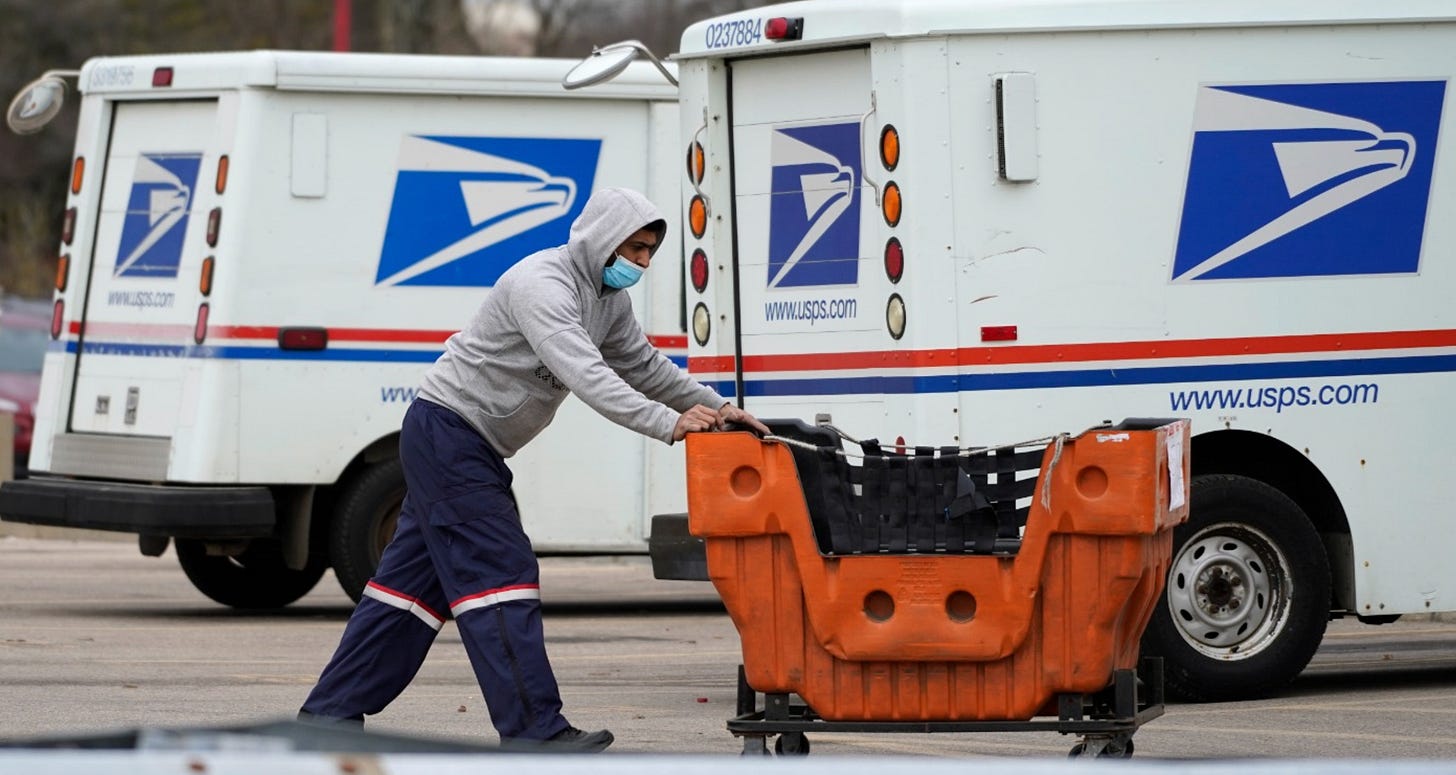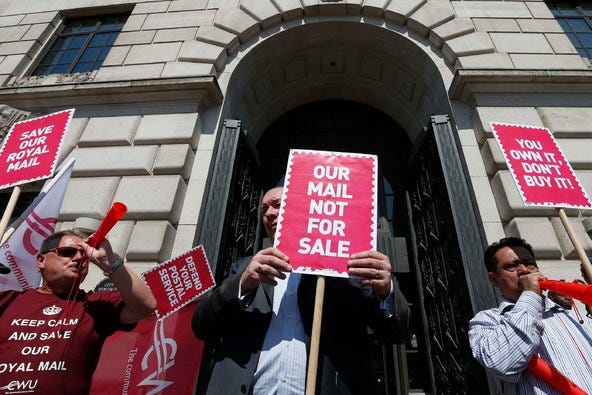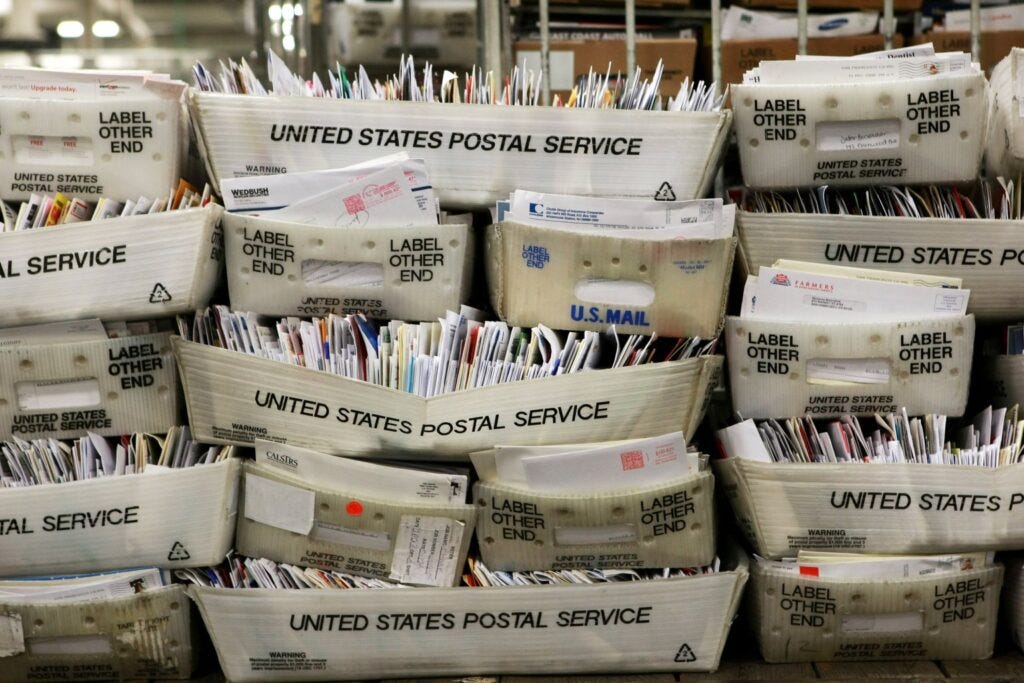Selling the Post Office?
Can it even be privatized?
Sponsored by
Kate Vicario relies on the United States Postal Service to keep her family alive.
Her mother and husband receive life-saving medication in the mail. So, when her mother’s diabetes and blood pressure medications were delayed for two weeks, she panicked.
“This isn’t ‘oh your package is lost,’ this is ‘you’re messing with my family’s health,” Vicario said. “I could lose family members.”
Vicario is one of millions of Americans who rely on the postal service to deliver their medication, and sometimes, that medication comes too late. Or worse, it never comes at all.
Unfortunately, her story isn’t unique. The United States Postal Service is plagued with problems: late deliveries, post office branches closing, increasing costs, and massive deficits.
But, according to the public, it’s still a national treasure. The USPS has one of the highest approval ratings of any government agency — only the National Park Service is thought of more highly by Americans.
The postal service is older than America itself. It was officially established in 1775, but the colonies had various types of letter and package delivery dating back to the 1630s.
During the colonial period, the mail system was run by the British crown, and its primary purpose was for the monarchy to communicate with colonial leaders. And it wasn’t exactly trusted by those in the new world.
The British would snoop, reading letters from colonists writing to family and friends back home in England. Things got so bad that colonists had to write in code to conceal the true nature of their letters.
So the development of a postal service that was not connected to the crown was a way to break free from the king’s far-reaching grasp.
With so little infrastructure in the form of passable roads, getting a letter from Jack in Boston to Samuel in Philadelphia was not a small feat, and the first postmaster general, Benjamin Franklin, decided he would recalculate mail routing to cut down on delivery times. In some cases, he was able to trim weeks off the travel time of a letter, which revolutionized how people were able to communicate with each other.
In the decades to follow, the postal service exploded. Between 1790 and 1860, the number of post offices went from 75 to more than 28,000, and post roads expanded to cover 240,000 miles.
Things really changed during the Civil War when the postmaster general decided families receiving letters about dead loved ones shouldn’t have to go to the post office. It was more humane for them to receive the news at home.
In 1863, Congress officially authorized the delivery of mail to individual residences, which led to houses getting actual addresses. Communities added sidewalks for postal carriers.
Eventually, rural free delivery was introduced, which meant people who lived outside of city centers no longer had to make long trips into town to collect their correspondence.
It’s one of the reasons the USPS is so beloved: You can live at the bottom of the Grand Canyon in Arizona, the side of a volcano in Hawaii, or the Arctic tundra of Alaska, and the USPS must deliver to you. No other delivery service will make that promise, because those routes are just not profitable.
But it’s also one of the reasons the USPS is in trouble.
The postal service can’t afford to do all the things it needs to do, like paying workers a competitive wage, delivering mail where it's obligated to, while also keeping costs low for users. They have fierce competition from other companies, and people just aren’t using the post office as much as they used to.
In 1970, following a year of violent strikes by postal workers, President Richard Nixon acquiesced to demands to recognize a postal workers’ union. The reforms also established a universal service obligation, meaning that the post office had to deliver everywhere. But, baked into the deal was notion that the federal government wouldn’t guarantee them taxpayer funding.
Although the USPS did continue to receive some federal subsidies, it hasn’t since 1990.
For decades, after the passage of the reorganization plan, the USPS managed to mostly operate in the green.
But, in 2006, Congress passed the Postal Accountability and Enhancement Act, which imposed a new requirement on the postal service: calculate all your healthcare funding for retirees over the next 75 years and start paying for them over the next ten years.
Different perspectives on the same facts can lead to significant differences in how news is presented. News sources can often provide different spin on the same facts based on their political tilt. Ground News is a great resource to help you navigate this.
As an app and website, it compiles sources from around the world, letting you compare coverage across the political spectrum. It gives you context into each source’s bias, reliability, and ownership, so you can make sense of the information you’re consuming.
Ground News is offering my community a 50% discount on unlimited access to the Vantage Plan. To subscribe, click this link or go to ground.news/preamble. It’s their best deal of the year at a time when we can all use some help balancing our news consumption.
Congress passed the law after the agency lost $2 billion between 2001-2002, and a report from the Government Accountability Office predicted further losses. Essentially, Congress wanted the agency to control its spending and establish a rainy day fund. They feared that the USPS wouldn’t be able to pay for its obligations in the future. Luckily for the current postmaster general, Louis DeJoy, Congress did away with this prefunding requirement in 2022.
The postal service has actually demanded some restitution from the federal government for being forced to prefund these retirement savings, which it says amounted to $111 billion.
The internet has also made things more difficult for the postal service. Letters have largely been replaced by email and other online services. And you no longer to say, “The check is in the mail.” You can just pay electronically.
The combination of of these factors have conspired to mean that the postal service is losing billions of dollars.
So, how does it get fixed?
The idea of privatizing the post office has been around for years, and Donald Trump has recently suggested he’s open to it. Privatization could rid the government of its responsibility for the agency, allowing it to be sold off, either as a whole, or for its component parts.
In Trump’s first term, his administration outlined a plan to privatize the postal service in a document entitled “Delivering Government Solutions in the 21st Century.”
The document suggests that the postal service could be privatized “through an initial public offering (IPO) or sale to another entity.” The document acknowledges that this “would require the implementation of significant reforms prior to sale to show a possible path to profitability.” In other words, nobody is going to want to buy a business that is losing so much money without a solid plan to turn it around. Trump’s plan didn't explain what that path would be.
The document also referenced European countries as successful privatization models. The UK, for example, took the Royal Mail private in 2013.
It’s changed hands a number of times — most recently on December 16, when it was sold to a Czech billionaire.
While the Royal Mail turned $76 million in profit in the last six months, its delivery times haven’t gotten faster, and the cost of its services keep going up. And let’s not forget that the UK is far more compact than the United States, which certainly impacts the overall costs and speed of delivery.
In order to be solvent in the future, the USPS says it has to modernize. But in order to make major investments in infrastructure, they need money that they don’t have. Postmaster DeJoy says that by going into debt now to replace the postal service’s aging equipment with new state-of-the-art robotics, electric vehicles, and mail boxes, they can cut down on the amount of lost mail, the amount spent on fuel, and how fast mail is processed.
The changes would require the postal service to take out loans from the government, but there’s no guarantee Congress and the Treasury would agree to give them that loan. In 2020, the the postal service received a $10 billion loan, but the loan was largely used to help fund its operations during the COVID-19 pandemic, not modernize its services. The USPS is now looking for another $14 billion loan to continue its transition into the information age.
Like the Royal Mail sell-off, Congress could introduce legislation that would similarly sell off the postal service to a private company. There are no bills on the floor currently, but such a system might look quite similar to theirs. The privatized Royal Mail also has to honor their version of the universal service obligation.
This wouldn’t be the first time the US has sold off portions of its operations to private companies. Private prisons, hospitals, and roads are governed by the same laws that govern the public versions of those institutions.
With so many pressures mounting on such an essential service, it's not unthinkable that radical actions to transform the agency could be tried. Trump is not alone in calling for it to be privatized, many of his Republican colleagues have as well. And, with a Republican controlled Congress, it’s the kind of effort we might be seeing more of in the near future.
Would love to hear your thoughts on if the USPS should be privatized! Tell me in the comments.












This comment isn’t about privatization as much as it’s about my sadness over the increasingly narrow purpose of the USPS and what that means for our society. As someone who deeply values the art of sending handwritten letters and cards, I can’t help but feel that we are losing something vital. For centuries, letters have preserved the informal history of our world. They allow us to glimpse the thoughts, emotions, and everyday lives of those who came before us, providing a uniquely human record of our shared experiences.
With the dominance of digital communication and the decline of handwritten correspondence, we risk losing that tangible, deeply personal connection. Emails and text messages, while convenient, are ephemeral. They lack the weight, permanence, and emotional resonance of a handwritten letter. A letter is something you can hold, revisit, and treasure—a piece of someone’s time and care captured on paper. Or maybe I’m just being dramatically nostalgic!
The same people who want to sell USPS are the same people who have actively worked to derail its service, so now they can say, “Look how expensive it is! It’s not working!” and use it to build support for a sale.
We’re now seeing what happens when Private Equity gets a hold of hospitals, prisons, and other necessary public entities (not to mention restaurant chains and retail), and it’s not good. If the USPS were to be sold, there needs to be some solid guardrails written into the sale.